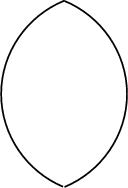|
|
|

A figure composed of two equal and symmetrically placed circular Arcs. It is also known as the Fish
Bladder (Pedoe 1995, p. xii) or Vesica Piscis. The latter term is often used for the particular lens formed by the
intersection of two unit Circles whose centers are offset by a unit distance (Rawles 1997). In this
case, the height of the lens is given by letting ![]() in the equation for a Circle-Circle Intersection
in the equation for a Circle-Circle Intersection
| (1) |
| (2) |
| (3) |
Renaissance artists frequently surrounded images of Jesus with the vesica piscis (Rawles 1997). An asymmetrical lens is produced by a Circle-Circle Intersection for unequal Circles.
See also Circle, Circle-Circle Intersection, Flower of Life, Lemon, Lune (Plane), Reuleaux Triangle, Sector, Seed of Life, Segment, Venn Diagram
References
Pedoe, D. Circles: A Mathematical View, rev. ed. Washington, DC: Math. Assoc. Amer., 1995.
Rawles, B. Sacred Geometry Design Sourcebook: Universal Dimensional Patterns. Nevada City, CA: Elysian Pub., p. 11, 1997.